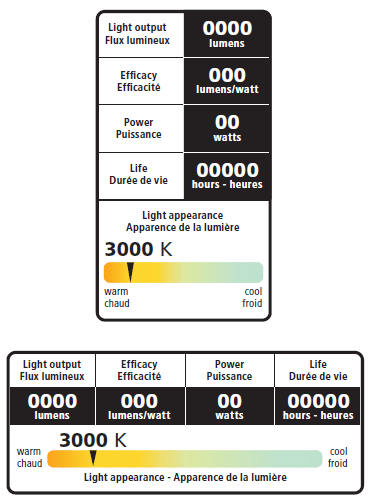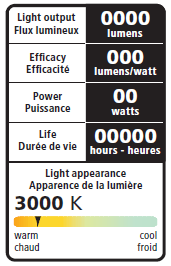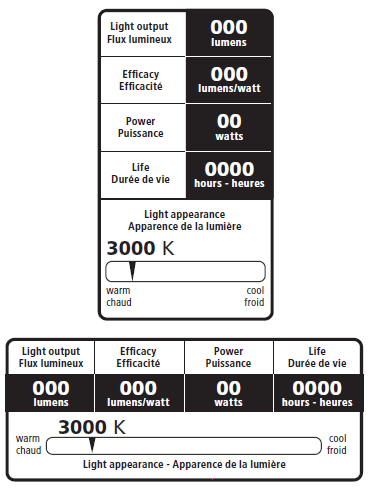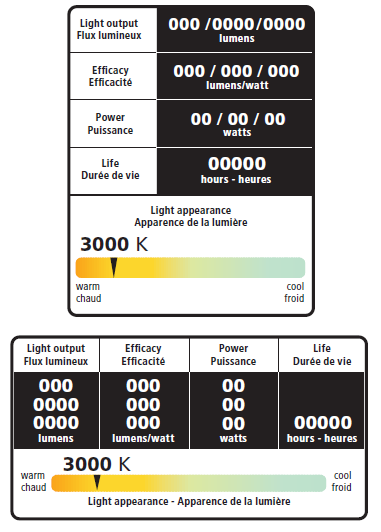July 2022
Technical bulletin on developing the standards
On April 1, 2022, the Office of Energy Efficiency at Natural Resources Canada (NRCan) updated its Forward Regulatory Plan which identifies its intention to amend Canada’s Energy Efficiency Regulations (the Regulations) to align General Service Lamps (GSLs) with energy efficiency standards, testing standards and the scope in the United States.
This technical bulletin has been released to initiate the consultation process and to collect stakeholder views on the requirements being considered for GSLs.
Input received during this stage of the process will inform the development of the next amendments considered. In addition, NRCan will undertake a cost-benefit analysis using the best available Canadian market data to assess the economic and environmental impacts of these new and updated standards and to ensure Canadian consumers and businesses benefit from their implementation.
The Government of Canada intends to pre-publish a regulatory proposal in the Canada Gazette, Part I, in 2023.
Background
In Canada, the following GSLs are subject to the Regulations:
- General Service Lamps (GSIL)Footnote 1 manufactured as of September 1, 2008
- Modified Spectrum Incandescent Lamps (MSIL) manufactured as of September 1, 2008
- Compact Fluorescent Lamps (CFL) manufactured as of June 1, 2009
- General Service Incandescent Reflector Lamps (GSIRL) manufactured as of December 31, 1996
GSLs use a significant portion of total residential building energy consumption. The proposed energy efficiency standards would save energy and reduce energy costs for Canadians. The efficiency standards would also reduce energy-related greenhouse gas emissions and help encourage manufacturers to adopt efficient product designs.
In 2018, the Memorandum of Understanding between the Treasury Board of Canada Secretariat and the United States Office of Information and Regulatory Affairs Regarding the Canada–United States Regulatory Cooperation Council was signed to move forward on energy efficiency and foster alignment of federal regulations where feasible and appropriate. In 2021, NRCan and the United States Department of Energy (U.S. DOE) signed the Memorandum of Understanding Between the Department of Natural Resources of Canada and the Department of Energy of the United States of America Concerning Cooperation on Energy, which acknowledges that both countries will collaborate on new and updated energy efficiency and testing standards where feasible and appropriate.
On May 9 2022, the U.S. DOE published a Federal Register final rule pertaining to GSL, which expanded the scope to include additional lamp types, such as light emitting diode and organic light emitting diode lamps among others (87 FR 27461). On that day, the U.S. DOE also published a Federal Register final rule prescribing revised energy efficiency standards for GSL (87 FR 27439). The effective dates for the expanded scope and energy efficiency standards are July 8 and July 25, 2022, respectively.
NRCan is considering amending the Regulations to align with the expanded scope, test procedures, and revised energy efficiency standards of the U.S. DOE. The intent is to consolidate all GSL that are currently subject to the Regulations, including GSIL, MSIL, CFL, and GSIRL, with currently unregulated lamp types, such as light emitting diode and organic light emitting diode lamps among others, into a broader GSL category.
Product description
In Canada, the following GSLs are currently subject to the Regulations:
A GSIL is defined in the Regulations as an electrical device that provides functional illumination and has a luminous flux of at least 310 lm but not more than 2,600 lm, a nominal voltage of at least 110 V but not more than 130 V or a nominal voltage range that lies at least partially between those voltages and a screw base. It does not include any of the following:
- an appliance lamp;
- a CFL;
- a coloured lamp;
- an infrared lamp;
- a lamp that has a G-shape as specified in ANSI C78.20 and ANSI C78.79 and a diameter of 12.7 cm or more;
- a lamp that has a T-shape as specified in ANSI C78.20 and ANSI C78.79 and a maximum nominal power of 40 W or a length of more than 25.4 cm or both;
- a left-hand thread lamp;
- a plant lamp;
- an incandescent reflector lamp;
- a vacuum type or gas-filled lamp that has a sufficiently low bulb temperature to permit exposed outdoor use on high-speed flashing circuits and that is marketed as a sign service lamp;
- a silver bowl lamp;
- a traffic signal module, a pedestrian module or a street light;
- a submersible lamp;
- a lamp that has a screw base size of E5, E10, E11, E12, E17, E26/50×39, E26/53×39, E29/28, E29/53×39, E39, E39d, EP39 or EX39 as specified in ANSI C81.61;
- a lamp that has a B, BA, CA, F, G16-½, G25, G30, S or M-14 shape or other similar shape as specified in ANSI C78.20 and ANSI C78.79 and a maximum nominal power of 40 W;
- a lamp that emits visible light produced by a current passing through a p-n junction solid state device; or
- a modified spectrum lamp.
A CFL is defined in the Regulations as an integrally ballasted compact fluorescent lamp that has:
- a medium screw base; and
- a nominal voltage of at least 100 V but not more than 130 V or a nominal voltage range that lies at least partially between those voltages.
A MSIL is defined in the Regulations as a modified spectrum lamp that has a luminous flux of at least 232 lm but not more than 1,950 lm, a nominal voltage of at least 110 V but not more than 130 V or a nominal voltage range that lies at least partially between those voltages, and a screw base. It does not include any of the following:
- an appliance lamp;
- a CFL;
- an infrared lamp;
- a lamp that has a G-shape as specified in ANSI C78.20 and ANSI C78.79 and a diameter of 12.7 cm or more;
- a lamp that has a T-shape as specified in ANSI C78.20 and ANSI C78.79 and a maximum nominal power of 40 W or a length of more than 25.4 cm or both;
- a lamp that uses solid state technology, namely, a lamp with a light source that comes from light-emitting diodes;
- a left-hand thread lamp;
- a plant lamp;
- an incandescent reflector lamp that has a shape specified in ANSI C78.79;
- a vacuum type or gas-filled lamp that has a sufficiently low bulb temperature to permit exposed outdoor use on high-speed flashing circuits and that is marketed as a sign service lamp;
- a silver bowl lamp;
- a traffic signal module, a pedestrian module or a street light;
- a submersible lamp;
- a lamp that has a screw base size of E5, E10, E11, E12, E17, E26/50×39, E26/53×39, E29/28, E29/53×39, E39, E39d, EP39 or EX39 as specified in ANSI C81.61; and
- a lamp that has a B, BA, CA, F, G16-½, G25, G30, S or M-14 shape or other similar shape as specified in ANSI C78.20 and ANSI C78.79 and a maximum nominal power of 40 W.
A GSIRL is defined in the Regulations as an incandescent reflector lamp that has a bulb shape described in ANSI C78.79 or a bulb shape similar to that shape, and that has an E26/24 single contact or E26/50×39 skirted medium screw base, a nominal voltage of at least 100 V but not more than 130 V or a nominal voltage range that lies at least partially between those voltages, a diameter of more than 57 mm and a nominal power of at least 40 W but not more than 205 W. It does not include any of the following:
- a coloured lamp;
- a rough service lamp;
- a vibration service lamp;
- a BR30 or BR40 lamp that has a nominal power of 50 W or less or of 65 W;
- an R20 lamp that
- has a nominal power of 45 W or less, or
- has a nominal power of 100 W and a nominal overall length of not more than 92 mm (3.625 inches) and is designed and marketed for pool and spa applications; or
- a modified spectrum lamp that
- is an ER30 or ER40 lamp, that has a nominal power of 50 W or less,
- is an ER40 lamp that has a nominal power of 65 W, or
- was manufactured before July 15, 2012.
NRCan is intending to consolidate existing regulatory categories for GSIL, MSIL, CFL and GSIRL into a broader General Service Lamps category and align our regulatory definition for GSL with that of the U.S. DOE, as follows:
General service lamp means a lamp that:
- has an ANSI base;
- is able to operate at a voltage of 12 volts or 24 volts, at or between 100 to 130 volts, at or between 220 to 240 volts, or of 277 volts for integrated lamps (as defined in this section), or is able to operate at any voltage for non-integrated lamps (as defined in this section);
- has an initial lumen output of greater than or equal to 310 lumens (or 232 lumens for modified spectrum general service incandescent lamps) and less than or equal to 3,300 lumens;
- is not a light fixture;
- is not an LED downlight retrofit kit; and
- is used in general lighting applications.
General service lamps include, but are not limited to, general service incandescent lamps, compact fluorescent lamps, general service light-emitting diode lamps, and general service organic light-emitting diode lamps. General service lamps do not include:
- Appliance lamps;
- Black light lamps;
- Bug lamps;
- Coloured lamps;
- G-shape lamps with a diameter of 127 mm (5 inches) or more as defined in ANSI C79.1-2002;
- General service fluorescent lamps;
- High intensity discharge lamps;
- Infrared lamps;
- J, JC, JCD, JCS, JCV, JCX, JD, JS, and JT shape lamps that do not have Edison screw bases;
- Lamps that have a wedge base or prefocus base;
- Left-hand thread lamps;
- Marine lamps;
- Marine signal service lamps;
- Mine service lamps;
- MR shape lamps that have a first number symbol equal to 16 (diameter equal to 50.8 mm (2 inches)) as defined in ANSI C79.1-2002, operate at 12 volts, and have a lumen output greater than or equal to 800;
- Other fluorescent lamps;
- Plant light lamps;
- R20 short lamps;
- Reflector lamps (as defined in this section) that have a first number symbol less than 16 (diameter less than 50.8 mm (2 inches)) as defined in ANSI C79.1-2002 and that do not have E26/E24, E26d, E26/50x39, E26/53x39, E29/28, E29/53x39, E39, E39d, EP39, or EX39 bases;
- S-shape or G-shape lamps that have a first number symbol less than or equal to 12.5 (diameter less than or equal to 39.70.8 mm (1.5625 inches)) as defined in ANSI C79.1-2002;
- Sign service lamps;
- Silver bowl lamps;
- Showcase lamps;
- Specialty MR lamps;
- T-shape lamps that have a first number symbol less than or equal to 8 (diameter less than or equal to 25.4 mm (1 inch)) as defined in ANSI C79.1-2002, nominal overall length less than 305 mm (12 inches), and that are not compact fluorescent lamps (as defined in this section); and
- Traffic signal lamps.
Testing standard
NRCan is considering referencing the following testing standard, using an ambulatory incorporation by reference:
- Paragraph 430.23(gg) of Subpart B, Part 430 of Title 10 to the U.S. Code of Federal Regulations, entitled General Service Lamps.
Energy efficiency standard
The energy efficiency standard under consideration for GSL is that all products covered under the revised scope must meet a minimum efficacy of 45 lumens per watt (lm/W).
Important dates
These modifications to the Regulations would come into force six months after the date of publication in the Canada Gazette, Part II.
NRCan is considering applying the updated energy efficiency standards to GSIL that are manufactured on or after January 1, 2024, and to all other lamps that are subject to the Regulations but are not GSIL, that are manufactured on or after January 1, 2025.
NRCan is considering applying the labelling requirements described below to all GSL manufactured on or after January 1, 2025.
Labelling requirements
Background
NRCan is proposing to implement new labelling requirements for GSLs. For those lamps already requiring product labelling, these will update existing requirements and for those lamps not yet regulated, these will be new requirements.
In recent years the availability and affordability of energy efficient lighting products has increased significantly. Consumers are demanding energy efficient products, but they are faced with a myriad of choices and the information required to identify energy efficient products is not always readily available. It is important that accurate information is provided to consumers of energy using products in a consistent manner so that they can make informed choices.
The new design aims to increase the label’s visibility and to ensure a common look to the information it provides. A consistent label will permit comparison among products using different technologies and encourage the selection of energy efficient products resulting in energy and economic savings.
The currently proposed label uses lamp efficacy as a measure of efficiency. It also includes light output in lumens, rather than the traditionally used wattage, as a measure of brightness. The new label will provide verified and reliable information to Canadian consumers and ensure that the product will perform as stated.
As all manufacturers must provide French/English bilingual labelling for lighting products sold in Canada, there will always be differences between labelling in the U.S. and Canada. Therefore, label alignment with the U.S. is not under consideration.
Descriptions and examples
The new labels in bilingual format for one-way or three-way lamps shall appear on the packaging of general service lamps, as defined above.
A label continues to be required for the common package of fixtures with lamps and for each type of lamp in a common package.
The bilingual label will have to be displayed on the principal panel of the packaging containing the lamp.
One-way lamp:

Text version
Two labels will be proposed for one-way lamps. The vertical label is taller than it is wide. The horizontal label is wider than it is tall. Each consists of five fields of information.
For the vertical label, the information includes, from the top down: light output, measured in lumens; efficacy, in lumens per watt; power, in watts; life, in hours; and light appearance. Light appearance is a larger field as it includes the lamp’s correlated colour temperature, in degrees Kelvin, as well as a horizontal graduated colour bar that indicates the quality of light from warm on the left to cool on the right. The left end of the colour bar is a deep orange. It is labelled warm and represents a colour temperature of approximately two thousand five hundred degrees Kelvin. Moving to the right, the colour bar shifts to light orange through yellow to blue at the right end of the colour bar. The right end is labelled cool and represents a colour temperature of approximately seven thousand degrees Kelvin. The lamp’s light appearance is indicated by an inverted isosceles triangle overlaid on the colour bar at the appropriate correlated colour temperature. The correlated colour temperature is printed above the bar. In this example, the triangle is to the left in the orange section of the colour bar with a labelled correlated colour temperature of three thousand Kelvin. This is similar to that of a traditional incandescent lamp which is typically about two thousand Kelvin.
For the horizontal label, the information includes, from left to right: light output, measured in lumens; efficacy, in lumens per watt; power, in watts; and life, in hours. These four information fields are overtop of a single field for light appearance. Light appearance is a larger field as it includes a horizontal graduated colour bar that indicates the quality of light from warm on the left to cool on the right. The lamp’s correlated colour temperature, in degrees Kelvin, is printed above the colour bar. The left end of the colour bar is a deep orange. It is labelled warm and represents a colour temperature of approximately two thousand five hundred degrees Kelvin. Moving to the right, the colour bar shifts to light orange through yellow to blue at the right. The right end is labelled cool and represents a colour temperature of approximately seven thousand degrees Kelvin. The lamp’s light appearance is indicated by an inverted isosceles triangle overlaid on the colour bar at the appropriate correlated colour temperature. The correlated colour temperature value is printed above the bar.
These two labels for one-way lamps may also be printed in monochrome, in other words, in black and white. This is a choice on the part of the manufacturer or dealer that will depend on package design and printing capabilities. The vertical and horizontal labels described previously may be printed in black and white such that the colour bar for light appearance remains labelled from warm on the left to cool on the right (but has no corresponding representative colour gradation). The bar is white with a thin black outline.
Examples of vertical and horizontal labels for three-way lamps are also provided. But as a three-way lamp has three brightness settings, each of the fields for light output, efficacy and power include three values for low, medium, and high settings. The fields for life and for light appearance remain identical to the previously described labels. Three-way lamp labels may also be printed in colour or in black and white.
The templates are provided in the size at which they should appear on the package. However, they can be enlarged to accommodate larger packaging and can also be reduced up to 30% to fit smaller packaging. The 30% reduction can only be used if the full size label covers over 25% of the area of the principal display panel.
If the label that has been reduced by 30% still covers over 25% of the area of the principal display panel, then the label may be reduced by 30% and have its blank spaces, including the colour bar thickness, reduced to compress the footprint while remaining legible (as shown below) or it can be moved to a side or back panel and may be reduced 20% from full size.

If the printing process is not four-colour, then the black and white label must be used.

Three-way lamp:

In the case of a three-way lamp, a specific label template will need to be used to display information for each level of operation. Either case must follow the same conditions on sizing and colour mentioned above.
Terms are defined in the Regulations or refer to metrics currently defined in the Regulations:
- Light output (Flux lumineux) refers to luminous flux in lumens (lm);
- Efficacy (Efficacité) refers to the measured lumen output of a lamp divided by the lamp power (lm/W);
- Power (Puissance) refers to lamp power in watts (W);
- Life (Durée de vie) refers to lamp life in hours; and
- Light appearance (Apparence de la lumière) refers to correlated colour temperature in degrees Kelvin (K).
Labelling requirements would apply to GSLs manufactured on or after January 1, 2025.
Verification requirements
For all GSLs products currently regulated, NRCan is not considering any changes for the verification requirements for these products.
These products will continue to carry a third party verification mark indicating that the product meets the energy efficiency standard and that the information to be reported has been verified.
For all products newly regulated under the GSLs scope, NRCan would require that these products carry a third party verification mark, either on the product or on the product’s package, indicating that the product meets the energy efficiency standards and that information to be reported has been verified.
The verification mark is the mark of a Standards Council of Canada accredited certification body that operates an energy efficiency certification program for the product.
Reporting requirements
Energy efficiency report
The energy efficiency report required for GSLs would include the following product specific information:
- Name of product (i.e. general service lamp)
- Brand name
- Model number
- Name of the manufacturer
- Name of the certification body whose verification mark will be affixed to the product
- Whether a mathematical model was used to generate any of the information provided
- A description of the lamp
- Its colour rendering index
- Its correlated colour temperature
- Its nominal power, expressed in watts
- Its luminous flux, expressed in lumens
- Its life, expressed in hours
The Regulations apply to products imported or shipped inter-provincially for sale or lease in Canada. This report must be submitted, by the dealer, to NRCan before the product is imported into Canada or traded inter-provincially for the first time.
Import report
A dealer who imports these products into Canada would include the following information on the customs release document:
- Name of product
- Model number
- Brand name
- Address of the dealer importing the product
- Purpose for which the product is being imported (i.e. for sale or lease in Canada without modification; for sale or lease in Canada after modification to comply with energy efficiency standards; or for use as a component in a product being exported from Canada)
Comments invited
The purpose of this bulletin is to provide stakeholders with the technical detail required to comment on the requirements under consideration for general service lamps.
It is important to NRCan that we engage the public and stakeholders on amendments to the Energy Efficiency Regulations. If you are aware of any dealer, manufacturer, importer, retailer, utility provider, small business, consumer group, organization, or representative of a specific group(s) of the population (including, but not limited to, women, 2SLGBTQQIA+ people, persons with disabilities, visible minorities, socio-economic status, residency, housing status, etc.), Indigenous peoples/communities, and/or other person or group that may be interested in participating in the amendment discussion and/or may be negatively impacted by this proposal, please forward them or the representative this bulletin. Please email equipment-equipement@nrcan-rncan.gc.ca to be added to the email distribution list (emails are used to notify stakeholders of upcoming amendments, technical bulletins, webinar registrations, and official publication in the Canada Gazette).
Additional information on Canada’s Energy Efficiency Regulations including a current list of Standards Council of Canada accredited certification bodies can be found on the Department’s website.
We welcome your comments by September 15, 2022. All correspondence should be forwarded to:
Natural Resources CanadaOffice of Energy Efficiency
580 Booth Street
Ottawa, ON, K1A 0E4
E-mail: equipment-equipement@nrcan-rncan.gc.ca
Email subject heading to be:
Bulletin – General Service Lamps – Lampes standard – July 2022 juillet